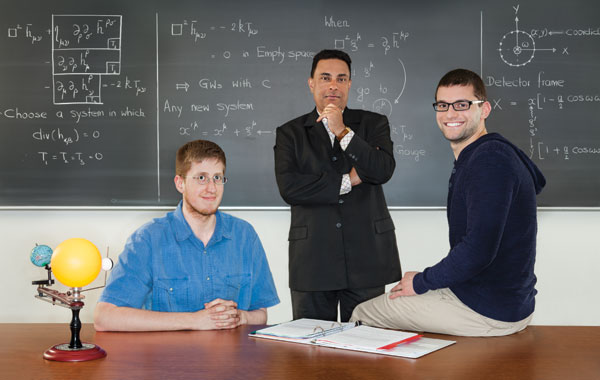A force to be reckoned with
Physicists have deduced that the universe began with the Big Bang 15 billion years ago, yet what happened afterward remains murky. This team of TCNJ researchers is looking back in space-time for ripples produced by the birth of the universe.

A Force to be Reckoned With

The Problem: Science has allowed physicists to deduce that the universe began with the Big Bang 15 billion years ago, yet what happened afterward remains murky. We simply can’t see back through space and time that far. The team is studying gravitational waves, a term used to describe ripples produced by the birth of the universe. These waves are known to reach the earth in a very weakened state, but have not been officially detected as of yet. (In March, a team of astronomers at Harvard reported they had observed gravitational waves through a telescope at the South Pole, but their report has yet to be corroborated.) The big challenge is to observe gravitational waves and extract information from them. That would allow scientists to learn what happened immediately after the Big Bang, when the dense, hot early universe violently expanded and cooled.
Their Theory: Common thinking holds that gravitational waves travel freely to Earth, but the team’s investigation has hinted this might not be the case. The group has theorized that gravitational waves might interact with charged particles in the early universe, with the result that the accelerating particles emit light from the waves. The team’s work is theoretical, not experimental. “It is extremely rigorous and very complex, not only for the students but also for me,” says Wickramasinghe, who has led the collaboration for over a year. Both students plan to pursue Ph.D.s in astronomy. “I am letting them learn from each other. It has been a wonderful journey.”
Their Takeaway: By probing the energy of gravitational waves, the team may have found a new method of detecting them. When and if the elusive waves are found, big-picture applications will start flowing. “A lot of what we do is what we call back-of-the-envelope calculations. We learn how the physical systems interact, and try to piece that together into a physical picture,” says Mitchell Revalski. Worldwide, fewer than 500 individuals are working in this poorly understood realm of the cosmos. In April, the trio presented its work at a forum on gravitational wave astrophysics in Barcelona, Spain. Revalski and Rhodes were the only undergraduates.
Professor: Thulsi Wickramasinghe
Students: Mitchell Revalski and Will Rhodes
Posted on May 22, 2014

